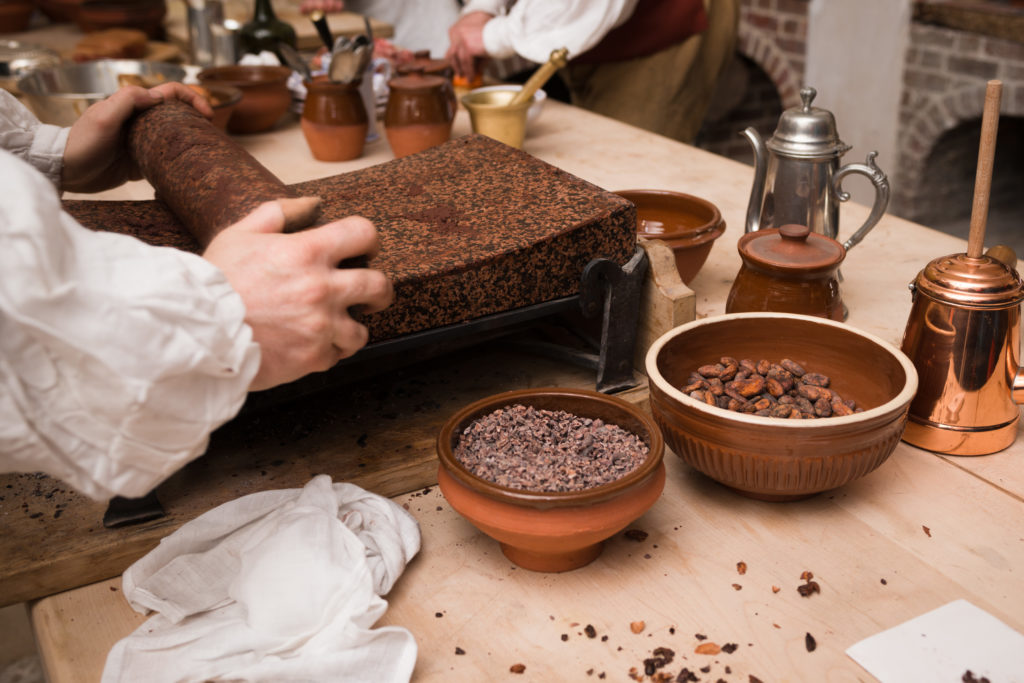In this article, taken from the fourth issue of Tafel Magazine, learn about the role chocolate played in the royal kitchen of William III and Mary II.
Chocolate Fit for a King: Thomas Tosier and the royal chocolate kitchen at Hampton Court Palace
By Annie Gray

Chocolate, Theobroma Cacao, food of the gods. Chocolate, which for centuries was not a food but a drink. Chocolate, so prestigious that a king and queen of Britain once built a set of rooms in its honour.
William III and Mary II aren’t the best-known of British rulers, but they were extremely important. Under their reign (1689-1702) came many milestones: the Bill of Rights, the Bank of England, and the steady popularization of chocolate in Britain.
The palaces William and Mary inherited when they came to power were dismal. So they rebuilt. At Hampton Court they added a grand baroque extension to the old-fashioned Tudor core, with all the latest modern conveniences—from a full enfilade (a suite of interconnected rooms whose doors are aligned) to an allegory-heavy entryway, and their very own privy (private) kitchen. In the eighteenth century, that kitchen was recorded on a plan as the chocolate kitchen, and it is known as that today.
For years, the chocolate kitchen was a storeroom, often filled with flowers for display. The discovery of the hitherto overlooked plan which stated its former use was a revelation. The kitchen must have been used for other cooking—it includes a (small) roasting range—but William, in particular, loved chocolate. He and Mary drank it as part of the levée, the intimate morning ceremony at which they dressed, surrounded by a select set of courtiers. William also quaffed chocolate throughout the day.
The couple even employed their own specialist chocolate maker, Solomon de la Faya. Later, when George I took over the throne, succeeding Mary’s sister Ann, he also inherited the kitchen and the chocolate room next door, where the specialist equipment was kept. He brought in Thomas Tosier as his chocolate maker.
Tosier was already well known in London, so this was not a lowly cook’s position, but one whereby George showed he had his finger on the pulse by employing a highly fashionable chef, and Tosier gained enormous prestige. His wife Grace ran their Greenwich chocolate shop while Tosier was at court. When Thomas died and she remarried, she kept the Tosier name. Grace took the business to new heights, becoming a true celebrity.
So what was royal chocolate like? The beans were probably roasted and ground before they got to the palace, made into cakes of pure cocoa liquor. Good sourcing was crucial—the beans tainted easily. Tosier would have melted the blocks down with water or milk, sugar, and flavours such as orange flower water, cinnamon, cloves, and chilli. Then he would have poured the mixture into a special chocolate pot, a vessel shaped like a coffee pot but with a hole in the top to contain the moulinet (or swizzle stick). In the royal bedchamber, he would have agitated the stick to froth the chocolate, before pouring it into tulip-shaped cups with deep saucers to hold them securely.
You can find recipes for Georgian chocolate online, including videos from the team at Hampton Court. They are well worth watching—and trying. After all, who wouldn’t want to drink chocolate fit for a king?
British food historian Annie Gray works as a writer, broadcaster and consultant. She’s the author of various books, including The Greedy Queen: eating with Victoria; Victory in the Kitchen: the life of Churchill’s Cook; and At Christmas we Feast: Festive food through the ages. She’s also a panellist on BBC Radio 4’s The Kitchen Cabinet (available as a podcast). Annie used to work in Stuart costume at Hampton Court, and she keeps a jar of spice specifically for flavouring seventeenth century chocolate in her cupboard at all times.
